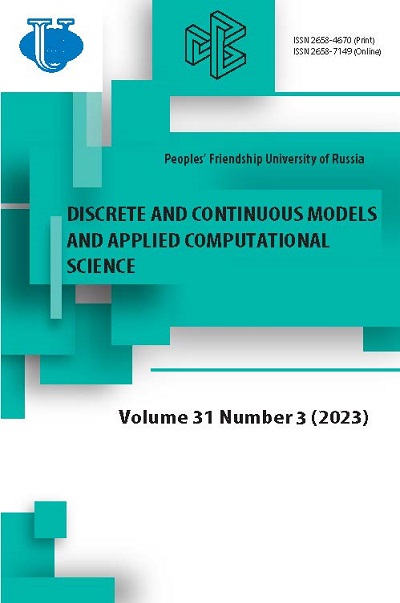Hamiltonian simulation in the Pauli basis of multi-qubit clusters for condensed matter physics
- Authors: André E.L.1,2, Tsirulev A.N.2
-
Affiliations:
- Agostinho Neto University
- Tver State University
- Issue: Vol 31, No 3 (2023)
- Pages: 247-259
- Section: Articles
- URL: https://journals.rudn.ru/miph/article/view/35921
- DOI: https://doi.org/10.22363/2658-4670-2023-31-3-247-259
- EDN: https://elibrary.ru/KRDBEG
- ID: 35921
Cite item
Full Text
Abstract
We propose an efficient method for Hamiltonian simulation of multi-qubit quantum systems with special types of interaction. In our approach, the Hamiltonian of a \(n\)-qubit system should be represented as a linear combination of the standard Pauli basis operators, and then decomposed into a sum of partial Hamiltonians, which are, in general, not Pauli operators and satisfy some anticommutation relations. For three types of Hamiltonians, which are invariant with respect to permutations of qubits, the effectiveness of the main algorithm in the three-qubit cluster model is shown by calculating the operator exponentials for these Hamiltonians in an explicit analytical form. We also calculate the density operator, partition function, entropy, and free energy of the cluster weakly coupled to a thermal environment. In our model, the cluster is in the Gibbs state in the temperature interval \(0.1\!-\!2\:\!\text{K}\), which corresponds to the operating range of modern quantum processors. It follows from our analysis that the thermodynamic properties of such systems strongly depend on the type of internal interaction of qubits in the cluster.
Full Text
1. Introduction In recent decades, effective mathematical methods and computational algorithms have been developed to simulate the dynamics of quantum systems and their thermodynamic properties on classical computers. It is believed that classical modeling of quantum systems, at least in quantum computation and chemical physics [1, 2], is potentially the shortest path to substantive quantum algorithms. In quantum information and condensed matter physics, the Hamiltonian simulation is one of the most important problems [3-5]. This problem can be mathematically formulated as the task of computing, exactly © André E.L., Tsirulev A.N., 2023 This work is licensed under a Creative Commons Attribution 4.0 International License https://creativecommons.org/licenses/by-nc/4.0/legalcode or approximately, the operator exponential exp(About the authors
Eduardo L. André
Agostinho Neto University; Tver State University
Email: lumonansoni@gmail.com
ORCID iD: 0000-0002-0697-1639
PhD student, Department of Applied Physics, Tver State University
7, Avenida 4 de Fevereiro, Luanda, Angola; 35, Sadovyi, Tver, 170002, Russian FederationAlexander N. Tsirulev
Tver State University
Author for correspondence.
Email: tsirulev.an@tversu.ru
ORCID iD: 0000-0003-4168-3613
Scopus Author ID: 16409936300
Doctor of Sciences in Physics and Mathematics, Professor of the Department of General Mathematics and Mathematical Physics
35, Sadovyi, Tver, 170002, Russian FederationReferences
- J. Preskill, “Quantum Computing in the NISQ era and beyond,” Quantum, vol. 2, p. 79, 2018. doi: 10.22331/q-2018-08-06-79.
- S. McArdle, S. Endo, A. Aspuru-Guzik, S. C. Benjamin, and X. Yuan, “Quantum computational chemistry,” Reviews of Modern Physics, vol. 92, no. 1, 2020. doi: 10.1103/revmodphys.92.015003.
- G. H. Low and I. L. Chuang, “Hamiltonian simulation by qubitization,” Quantum, vol. 3, p. 163, 2019. doi: 10.22331/q-2019-07-12-163.
- B. Zeng, X. Chen, D.-L. Zhou, and X.-G. Wen, Quantum Information Meets Quantum Matter. Springer New York, 2019. doi: 10.1007/9781-4939-9084-9.
- L. Bassman, M. Urbanek, M. Metcalf, J. Carter, A. F. Kemper, and W. A. de Jong, “Simulating quantum materials with digital quantum computers,” Quantum Science and Technology, vol. 6, no. 4, p. 043002, 2021. doi: 10.1088/2058-9565/ac1ca6.
- D. W. Berry, A. M. Childs, R. Cleve, R. Kothari, and R. D. Somma, “Simulating Hamiltonian dynamics with a truncated Taylor series,” Physical Review Letters, vol. 114, p. 090502, 9 2015. DOI: 10.1103/ PhysRevLett.114.090502.
- D. W. Berry, A. M. Childs, R. Cleve, R. Kothari, and R. D. Somma, “Exponential improvement in precision for simulating sparse Hamiltonians,” in Proceedings of the Forty-Sixth Annual ACM Symposium on Theory of Computing, New York, NY, USA, 2014, pp. 283-292. doi: 10.1145/2591796.2591854.
- I. M. Georgescu, S. Ashhab, and F. Nori, “Quantum simulation,” Reviews of Modern Physics, vol. 86, pp. 153-185, 1 2014. doi: 10.1103/RevModPhys.86.153.
- G. L. Deçordi and A. Vidiella-Barranco, “Two coupled qubits interacting with a thermal bath: A comparative study of different models,” Optics Communications, vol. 387, pp. 366-376, 2017. doi: 10.1016/j.optcom. 2016.10.017.
- C. Boudreault, H. Eleuch, M. Hilke, and R. MacKenzie, “Universal quantum computation with symmetric qubit clusters coupled to an environment,” Physical Review A, vol. 106, no. 6, p. 062610, 2022. doi: 10.1103/PhysRevA.106.062610.
- T. Menke et al., “Demonstration of tunable three-body interactions between superconducting qubits,” Physical Review Letters, vol. 129, no. 22, p. 220501, 2022. doi: 10.1103/PhysRevLett.129.220501.
- V. Verma and M. Sisodia, “Two-way quantum communication using four-qubit cluster state: Mutual exchange of quantum information,” Modern Physics Letters A, vol. 37, no. 04, p. 2250020, 2022. doi: 10.1142/S0217732322500201.
- J. Von Neumann, “Proof of the ergodic theorem and the H-theorem in quantum mechanics: translation in English,” European Physical Journal H, vol. 35, pp. 201-235, 2010.
- A. Kossakowski, A. Frigerio, V. Gorini, and M. Verri, “Quantum detailed balance and KMS condition,” Communications in Mathematical Physics, vol. 57, no. 2, pp. 97-110, 1977.
- G. Bulnes Cuetara, M. Esposito, and G. Schaller, “Quantum thermodynamics with degenerate eigenstate coherences,” Entropy, vol. 18, no. 12, 2016. doi: 10.3390/e18120447.
- A. Short and T. Farrelly, “Quantum equilibration in finite time,” New Journal of Physics, vol. 14, no. 1, p. 013063, 2012. doi: 10.1088/13672630/14/1/013063.
- M. A. Novotny, F. Jin, S. Yuan, S. Miyashita, H. De Raedt, and K. Michielsen, “Quantum decoherence and thermalization at finite temperature within the canonical-thermal-state ensemble,” Phys. Rev. A, vol. 93, no. 3, p. 032110, 2016. doi: 10.1103/PhysRevA.93.032110
Supplementary files















